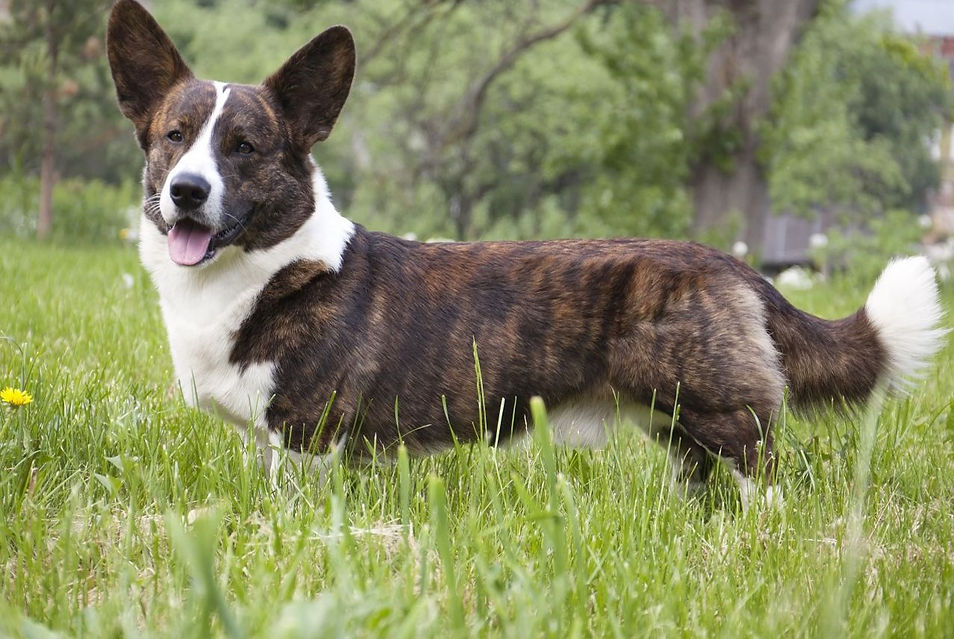



Welsh Corgi Cardigan
HISTORICAL SUMMARY:
IT'S regarded as one of the oldest herding breeds. Recognized as a race for over 1,000 years, its emergence has been speculated in a possible 3,000 years. until mid 19th century , it was the only dog bred by Welsh communities. Originally a herding animal on farms, due to its small size, enough to nibble on its heels and not get trampled. It is considered an alert and exuberant dog.
Country of Origin: Great Britain
GENERAL APPEARANCE L : Robust, strong, versatile and resistant. Long in proportion to height, ending in a fox tail, set in line with the body.
PRO IMPORTANT PORTIONS : The length of the muzzle should maintain a proportion to the skull of 3 to 5.
BEHAVIOR AND TEMPERAMENT : Alert, active, intelligent. Trustworthy, not shy, not aggressive .
HEAD : In shape and appearance of a fox.
CRANIAL REGION
skull : Wide and flat between the ears; tapering towards the eyes, above which it is slightly domed.
Stop : Moderate.
FACIAL REGION
Truffle : black; projects slightly, without being tapered.
Muzzle : Moderately thins towards the nose.
Jaws and Teeth : Strong teeth with a scissor bite. Lower jaw well defined, strong but not prominent.
eyes : Medium size, clean; amiable expression, alert but watchful. Inserted quite separately and with clearly defined corners. Preferably dark or in harmony with the coat; dark eyelid edges. Only blue merle specimens are allowed one or both light blue, blue, or blue-spotted eyes.
Ears : Upright, proportionately large in relation to the size of the dog. Slightly rounded tips, moderately wide at the base and set about 8 cm apart. Carried so that the tips are slightly separated by a straight line from the tip of the nose through the center of the eyes and set well back so that they can fall flat along the neck.
NECK : Muscular, well developed in proportion to the dog's frame, merging into well sloping shoulders.
TRUNK
Top Lines : Level
Loin : Clearly defined waist.
chest : Moderately wide and with a prominent sternum. Deep chest. Ribs well sprung.
TAIL: Shaped like a fox tail, set in line with the body and moderately long (touching or almost touching the ground). Carried low when at rest, but may be raised slightly above the body when in motion. Not rolled over the back.
MEMBERS
PREVIOUS : Strong bone. Short legs, but the body clearly separated from the ground.
Shoulders : Well placed, angled approximately 90° to muscular arms
Elbows : Close to the sides of the body
Forearms : Slightly arched to mold to the chest.
Paws : Round, closed, quite large and well padded. Slightly turned out.
HINDQUARTERS : Strong, well angled and in line with muscular thighs and legs; with strong bone throughout its entire length, up to the feet. Short legs.
Metatarsals : Vertical, when standing (in “stay”), seen in profile and from behind.
Paws : Round, closed, quite large and well padded.
DRIVE : Free and active; the elbows very close to the body; neither loose nor tied to the same. Forelegs with good reach, without lifting too much and in harmony with the propulsive action of the hindquarters.
COAT
By : Short or medium, with a hard texture. Weatherproof, with good undercoat. Preferably straight.
COLOR:
Any color, with or without white spots, but white should not predominate.
SIZE : 30 cm
FAULTS
Any deviation from the terms of this standard should be considered a fault and penalized in exact proportion to its severity and its effects on the health and well being of the dog.
DISQUALIFYING FAULTS
• Aggressiveness or excessive shyness.
• Any dog that shows any sign of physical or behavioral anomaly must be disqualified.
GRADES
• Males must present both testicles, of normal appearance, well let down and accommodated in the scrotum.
• Only clinically and functionally healthy dogs with typical breed conformation should be used for breeding.